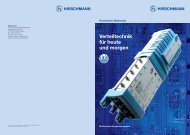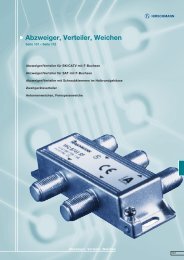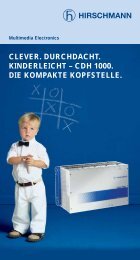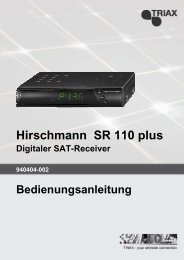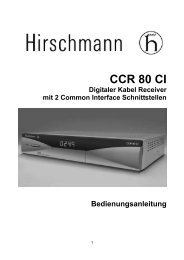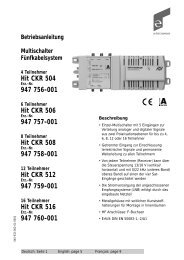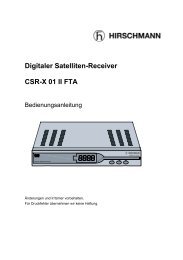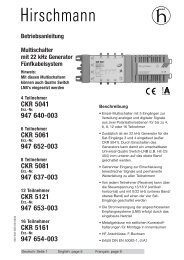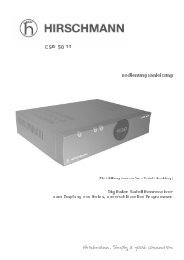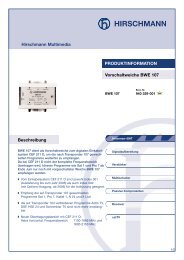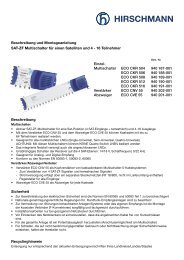CVE 9xxx - Vorverstärker
CVE 9xxx - Vorverstärker
CVE 9xxx - Vorverstärker
Erfolgreiche ePaper selbst erstellen
Machen Sie aus Ihren PDF Publikationen ein blätterbares Flipbook mit unserer einzigartigen Google optimierten e-Paper Software.
DiSEqC TM -Multischalter<br />
für Verteilsysteme<br />
DiSEqC TM -Multiswitches<br />
for cascadable systems<br />
02- 0600<br />
50/51076.59<br />
Hirschmann Multimedia Electronics GmbH<br />
Stuttgarter Straße 45-51<br />
D-72654 Neckartenzlingen<br />
Tel.: 0180 3232341<br />
Deutsch: Seite 1 / English: page 13 E-Mail: hme-info@hirschmann.de
Bedienungsanleitung<br />
Inhaltsverzeichnis<br />
Seite<br />
1. Anwendungsbereich 3<br />
2. Systemstruktur 3 - 4<br />
3. Außeneinheit 4<br />
4. Inneneinheit 5<br />
4.1 Kopfgeräte 5<br />
4.2 Kaskaden-Multischalter 6 - 7<br />
4.3 Strang-Verstärker 8<br />
5. Planungs- und Installationshinweise 8-9<br />
6. Anlagenbeispiel 10<br />
7. Sicherheitshinweise 11<br />
8. Hilfe bei der Fehlersuche 11 - 12<br />
Bitte lesen Sie vor der Installation diese Anleitung aufmerksam durch<br />
und beachten Sie besonders die Sicherheitshinweise auf Seite 11 !<br />
2
DiSEqC TM 2.0-Multischalter<br />
für SAT-ZF-Verteilsysteme<br />
Typ: <strong>CVE</strong> 9409 ND Bestell-Nr.: 940 003-002<br />
CNV 9009 ND 940 004-002<br />
CMK 9409 D 940 005-002<br />
CMK 9809 D 940 006-002<br />
1. Anwendungsbereich<br />
Die kaskadierbaren DiSEqC - Multischalter sind zur Verteilung von terrestrischen- und Sat-ZF-<br />
Antennensignalen bestimmt.<br />
Die Bauteile können z.T. einzeln oder in der Zusammenschaltung als Kaskade verwendet werden.<br />
Dabei können von jedem Teilnehmer (Receiver) die Programme von 8 Sat-ZF-Ebenen und des terrestrischen<br />
Bandes, einschließlich UKW, empfangen werden.<br />
Es spielt hierbei keine Rolle, ob die Programme analog oder digital übertragen werden.<br />
Der breitbandige terrestrische Eingang ist BK-tauglich.<br />
2. Systemstruktur<br />
Die Anlage besteht aus der Außeneinheit, d.h. einer oder mehrerer Satellitenantennen mit diversen<br />
LNB´s, sowie der Inneneinheit,die sich aus Verteilkomponenten der DiSEqC - Multischalter-Serie<br />
zusammensetzt:<br />
• Kopfgeräte <strong>CVE</strong><br />
• Kaskaden-Multischalter CMK<br />
• Strangverstärker CNV<br />
Die Inneneinheiten können sowohl konzentriert als Sternverteilung, oder gestreckt als Etagensternverteilung<br />
in einem oder mehreren Stämmen installiert werden.<br />
3
2. Systemstruktur<br />
Außen- und Inneneinheiten sind über 9 Strangleitungen aus dämpfungs- und widerstandsarmen<br />
75 Ohm Sat-Antennenkabeln miteinander verbunden.<br />
Dem Kopfgerät folgen Kaskaden-Multischalter. Je nach Aufbau und Größe der Anlage muß an geeigneter<br />
Stelle ein Strangverstärker eingesetzt werden, der die entstandenen Pegelverluste im Strang ausgleicht.<br />
Je nach Größe und Ausdehnung der Anlage sind zwischen der Außeneinheit und dem Kopfgerät eines<br />
Stammes eventuell Vorverstärker und Verteiler erforderlich.<br />
Antennen<br />
Kopfgerät<br />
In Bereichen mit schwächeren Empfangsfeldstärken sollte der Spiegeldurchmesser mindestens 1m betragen.<br />
Kaskaden-<br />
Multischalter<br />
Kaskaden-<br />
Multischalter<br />
Strangverstärker<br />
Kaskaden-<br />
Multischalter<br />
3. Außeneinheit<br />
An zentralen geografischen Orten der Satellitenausleuchtzonen werden Antennen mit Spiegeldurchmessern<br />
ab 80 cm empfohlen.<br />
Größere Spiegeldurchmesser verbessern allgemein das S/N (Signal/Rauschverhältnis) und damit die<br />
Schlechtwetterreserve.<br />
Zum Anschluß an die Anlage eignen sich Dual-,Twin-, Quattro- und Universal Quattro - LNB´s.<br />
Dabei ist besonders auf ein geringes Rauschmaß der LNB´s zu achten. Der Ausgangspegel am LNB sollte<br />
75 dBµV nicht unterschreiten.<br />
Für Standardanwendungen (Analog und Digital-Empfang von ASTRA und EUTELSAT) sollten vorzugsweise<br />
Quattro-LNB´s eingesetzt werden.<br />
4
4. Inneneinheit<br />
4.1 Kopfgeräte<br />
Ein Kopfgerät wird am Anfang einer Stammverteilung installiert. Es liefert die Spannungsversorgung für<br />
die LNB´s.<br />
Die Zahl der nachgeschalteten Multischalter hängt von den Pegelverhältnissen ab.<br />
<strong>CVE</strong> 9409 ND<br />
Das Kopfgerät bietet folgende Besonderheiten:<br />
• 8 Sat-ZF-Ein- und Ausgänge und 1 terrestrischer Ein-und Ausgang<br />
• Je nach Typ 4, 8 Teilnehmer-Ausgänge (Receiveranschlüsse)<br />
• Unterstützt den Steuersignalstandard DiSEqC bis Level 2.0<br />
• Arbeitet auch mit den Steuersignalen 13V/18V, 0/22kHz, Tonburst mod./unmod.<br />
• Die Signalführung im Strang ist passiv<br />
Technische Daten:<br />
Type / Bestell-Nr.: <strong>CVE</strong> 9409 ND 940 003-002<br />
Eingänge / Ausgänge 9 / 4<br />
Frequenzbereich 5 - 862 950 - 2400 MHz<br />
Strangdämpfung 4 +/-1 1 - 3 dB<br />
Dämpfung 21 +/-2 0 +/-2 dB<br />
Max. Ausg.-Pegel (35 dB IMA 3<br />
) - 102 dBµV<br />
Entkopplung H/V - >25 dB<br />
Max. Stromabgabe an LNBs (13V/18V) 350 / 700 mA<br />
Stromaufnahme v. Receiver (13V/18V) 50 / 75 mA<br />
Schaltnetzteil<br />
180...264VAC / 47-63Hz / 21 W<br />
5
4.2 Kaskaden-Multischalter<br />
Ein Kaskaden-Multischalter wird innerhalb der Stammverteilung nach dem Kopfgerät bzw.<br />
nach einem Strang-Verstärker installiert.<br />
CMK 9409 D<br />
CMK 9809 D<br />
Ein Kaskaden-Multischalter bietet folgende Besonderheiten:<br />
• 8 Sat-ZF-Ein- und Ausgänge und 1 terrestrischer Ein-und Ausgang<br />
• Je nach Typ 4, 8, Teilnehmer-Ausgänge (Receiveranschlüsse)<br />
• Unterstützt den Steuersignalstandard DiSEqC -Standards bis Level 2.0<br />
• Arbeitet auch mit den Steuersignalen 13V/18V, 0/22kHz, Tonburst mod./unmod.<br />
• Die Signalführung im Strang ist passiv<br />
6
Technische Daten:<br />
Type / Bestell-Nr.: CMK 9409 D 940 005-002<br />
Eingänge / Ausgänge 9 / 4<br />
Frequenzbereich 5 - 862 950 - 2400 MHz<br />
Strangdämpfung 4 +/-1 1 - 3 dB<br />
Dämpfung 21 +/-2 0 +/-2 dB<br />
Max. Ausg.-Pegel (35 dB IMA 3<br />
) - 102 dBµV<br />
Entkopplung H/V - >25 dB<br />
Stromaufnahme v. Receiver (13V/18V) 50 / 75 mA<br />
Type / Bestell-Nr.: CMK 9809 D 940 006-002<br />
Eingänge / Ausgänge 9 / 8<br />
Frequenzbereich 5 - 862 950 - 2400 MHz<br />
Strangdämpfung 6 +/-1 1 - 3 dB<br />
Dämpfung 23 +/-2 0 +/-2 dB<br />
Max. Ausg.-Pegel (35 dB IMA 3<br />
) - 102 dBµV<br />
Entkopplung H/V - >25 dB<br />
Stromaufnahme v. Receiver (13V/18V) 50 / 75 mA<br />
7
4.3 Strang-Verstärker<br />
Der Strang-Verstärker wird innerhalb der Stammverteilung eingesetzt, um Pegelverluste auszugleichen<br />
(Pegelbilanz beachten).<br />
CNV 9009 ND<br />
Der Strang-Verstärker bietet folgende Besonderheiten:<br />
• 8 Sat-ZF-Ein- und Ausgänge und 1 terrestrischer Ein-und Ausgang<br />
• Die Signalführungen im Strang sind für Sat-ZF und das terrestrische Band aktiv<br />
Technische Daten:<br />
Type / Bestell-Nr.: CNV 9009 ND 940 004-002<br />
Eingänge / Ausgänge 9 / 9<br />
Frequenzbereich 47 - 862 950 - 2400 MHz<br />
Verstärkung 19 ... 22 18 ... 22 dB<br />
Max. Ausg.-Pegel (35 dB IMA 3<br />
) - 110 dBµV<br />
Max. Ausg.-Pegel (60 dB IMA 2<br />
) 104 - dBµV<br />
Schaltnetzteil 180...265VAC / 47-63Hz / 9 W<br />
5. Planungs- und Installationshinweise<br />
Die Planung einer Verteilanlage für terrestrische- und Sat-ZF-Signale hängt stark von den<br />
örtlichen Gegebenheiten ab. Folgende Strukturen sind möglich:<br />
• Gestreckter Aufbau (Stammverteilung mit Etagensternverteilungen) eventuell mit mehreren Stämmen<br />
• Zentraler Aufbau (Sternverteilung)<br />
8
Beim gestreckten Aufbau sind die Baugruppen voneinander entfernt installiert. Es können sich Kaskaden-Multischalter<br />
in jeder Etage befinden, die durch 5-10 m lange Strangleitungen verbunden sind.<br />
Es folgen dann noch die 20-30m langen Teilnehmerleitungen bis zur Antennendose.<br />
Beim zentralen Aufbau ist die Anlage an einem Ort montiert, z.B. in Keller oder Dachboden, von wo aus<br />
z.T. sehr lange Teilnehmerleitungen (>30 m) bis zur Antennendose folgen.<br />
Das Erstellen eines Pegelplanes ist sinnvoll. Dabei müssen die Pegel für den terrestrischen- und den Sat-<br />
Bereich getrennt betrachtet werden.<br />
Ausgehend von der Antennendose mit der größten Entfernung zur Antenne werden die Signalpegel vom<br />
Mindestwert zurückgerechnet.<br />
Minimale und maximale Trägerpegel am Teilnehmeranschluss (Antennensteckdose)<br />
Frequenzbereich minimal maximal<br />
SAT-ZF 950 -2400 MHz 47 77 dBµV<br />
terr. 5 - 862 MHz 57 77 dBµV<br />
Anhand des Pegelplanes wird entschieden, wo ein Strang-Verstärker eingesetzt werden<br />
muß, um die Pegelverluste im Strang zu kompensieren.<br />
Durch lange Kabelstrecken entstehen Verzerrungen, d.h. bei niedrigen Frequenzen hat das Kabel geringe<br />
Dämpfung, bei hohen Frequenzen eine hohe Dämpfung.<br />
So entsteht eine Pegelschräglage, die durch einen Entzerrer oder einen entzerrten Verstärker ausgeglichen<br />
werden muß. Eine solche Entzerrung ist im Strang-Verstärker bereits integriert.<br />
Die längsten Teilnehmerkabel sollten an den Ausgängen mit den höchsten Pegeln angeschlossen werden,<br />
also am Kopfgerät, dessen folgenden Multischalter bzw. an dem Multischalter, der einem Strangverstärker<br />
folgt.<br />
Bei der Anlagenplanung ist neben der Pegelbetrachtung auch die Stromversorgung zu überprüfen,<br />
damit alle Komponenten einwandfrei arbeiten.<br />
Wichtiger Hinweis !<br />
Nichtbenutzte Ein-und Ausgänge müssen ebenso wie die Strangleitungen mit 75 Ohm<br />
Abschlußwiderständen abgeschlossen werden.<br />
Teilnehmerausgänge sowie Strangausgänge müssen mit Abschlußwiderständen<br />
abgeschlossen werden.<br />
9
6. Anlagenbeispiel<br />
10
7. Sicherheitshinweise<br />
• Vor Öffnen Netzstecker ziehen!<br />
• Installationsarbeiten nur bei gezogenem Netzstecker durchführen.<br />
• Die VDE-Bestimmungen 0100 und 0855 Teil 1 bzw. die Europanormen EN 50083 Teil 1 zur<br />
Gewährleistung der elektrischen Sicherheit sind zu berücksichtigen!<br />
• Nationale genehmigungsrechtliche Regelungen für Rundfunk-Empfangsanlagen sind zu beachten!<br />
• Die Anlagenteile sind zu erden und gemäß o.a. Bestimmungen gegen Blitzschlag zu schützen.<br />
• Die Bauteile sind an trockenen gut belüfteten Orten auf ebener schwerentflammbarer Unterlage<br />
zu montieren. Umgebungstemperaturen über 55° C sind zu vermeiden.<br />
• Zur Vermeidung von Störungen benachbarter Anlagen/Systeme oder des eigenen Empfangs ist<br />
die Montage der koaxialen Verbinder (F-Connectoren) sorgfältig und fachgerecht durchzuführen.<br />
Hierbei sind Kurzschlüsse zu vermeiden !<br />
Für Schäden, die auf nicht bestimmungsgemäßen Gebrauch oder Nichtbeachtung obiger Sicherheitshinweise<br />
entstehen, haftet der Hersteller nicht.<br />
8. Hilfe bei der Fehlersuche<br />
Fehler:<br />
Kein Empfang mit Analog- oder Digital-Receiver evtl. auch kein terrestrischer Empfang!<br />
Grund:<br />
a) Keine 230 V~ Netzspannung vorhanden.<br />
b) Eine Überlastung oder ein Kurzschluß an den LNB-Leitungen liegt vor!<br />
Abhilfe:<br />
a) Für ausreichend Netzspannung sorgen.<br />
b) LNB-Zuleitungen nacheinander entfernen und Kurzschluß beseitigen.<br />
Hinweis: Die 8 Strangleitungen in Richtung der LNB´s sind spannungsführend.<br />
Alle weiteren Strangleitungen sind spannungsfrei.<br />
11
Fehler:<br />
Kein Bild, obwohl die Versorgungsspannungen zu den LNB´s überprüft und in Ordnung<br />
sind.<br />
Grund:<br />
a) Empfangssignale vom LNB fehlen.<br />
b) Falsche Antennendosen installiert.<br />
c) Bei Verwendung von Universal Quattro-Switch LNB´s:<br />
Die für den Betrieb im High-Band erforderlichen 22kHz auf der Versorgungsspannung fehlen.<br />
Abhilfe:<br />
a) Antenne ausrichten bzw. defekten LNB austauschen, Versorgungsspannungen am LNB prüfen,<br />
um Kabelbruch auszuschließen.<br />
b) Die richtigen Antennendosen anschließen.<br />
c) 22kHz-Generatoren in die High-Band LNB-Versorgungsleitungen installieren.<br />
Fehler:<br />
Die terrestrischen Fernsehkanäle (47-862 MHz) sind gestört (Rauschen oder Moiré im<br />
Bild).<br />
Grund:<br />
Die Signalpegel innerhalb der Anlage sind nicht ordnungsgemäß eingestellt.<br />
Abhilfe:<br />
Es ist ein Pegelplan wie beschrieben aufzustellen, und die Signalpegel unter Zuhilfenahme eines Antennenmeßgerätes<br />
einzustellen.<br />
Dabei ist darauf zu achten, daß der Betriebspegel am jeweiligen Anlagenteil unter Berücksichtigung der<br />
übertragenen Kanalanzahl nicht überschritten wird.<br />
Änderungen und Irrtümer bleiben vorbehalten.<br />
DiSEqC TM ist ein eingetragenes Warenzeichen von Eutelsat. 02/2006<br />
12
Product manual<br />
Table of contents<br />
Page<br />
1. General description 14<br />
2. Structure of the system 14 -16<br />
3. Outdoor units 15- 16<br />
4. Indoor units 16 - 19<br />
4.1 Cascade head components 16 - 17<br />
4.2 Cascade-multiswitches 17 - 18<br />
4.3 Pre-amplifier 19<br />
5. Planning, installation and fixing notes 20<br />
6. Installation examples (Cascade multiswitch) 21<br />
7. Safety notes 22<br />
8. What to do in case of problems 23 - 24<br />
Important !<br />
Prior to the installation and fixing of this system make sure that you have<br />
read this product manual carefully and that you duly noted all safety notes<br />
page 22.<br />
13
DiSEqC TM 2.0-multiswitches<br />
for cascadable systems<br />
Type: <strong>CVE</strong> 9409 ND Order-No.: 940 003-002<br />
CNV 9009 ND 940 004-002<br />
CMK 9409 D 940 005-002<br />
CMK 9809 D 940 006-002<br />
1. General description<br />
The cascadable DiSEqC TM multiswitch series has been designed for the distribution of terrestrial and<br />
satellite IF antenna signals.<br />
Units can either be used individually or when interconnected as a cascadable system.<br />
Each subscriber (connected satellite receiver) can receive programs from 8 satellite-IF polarizations<br />
and the terrestrial range including FM-radio.<br />
It does not matter whether programs are digital or analogue.<br />
The broadband terrestrial input can be used for CATV signals.<br />
2. Structure of the system<br />
A complete system consists of an outdoor unit, i.e. one or more satellite antennas with various LNBs, and<br />
an indoor unit, consisting of various components of the multiswitch series.<br />
• head components <strong>CVE</strong><br />
• cascade multiswitches CMK<br />
• cascade amplifier CNV<br />
14
2. Structure of the system<br />
The indoor units can be installed in a star distribution structure or stretched as a floor star distribution<br />
with one or more trunk lines.<br />
Both outdoor and indoor units are interconnected via 9 trunk lines with low loss and low resistance 75<br />
Ohm satellite- coaxial cable.<br />
Subsequent to the cascade head component there will be cascade multiswitches. According to the set up<br />
and the size of the planned system the use of a cascade amplifier in a suitable position is recommendable,<br />
compensating the arising signal losses in the trunk lines.<br />
Moreover it might be advisable to install indoor pre-amplifier and splitter inbetween the outdoor unit and<br />
the cascade head component<br />
antennas<br />
head component<br />
cascade multiswitch<br />
cascade multiswitch<br />
cascade amplifier<br />
cascade multiswitch<br />
3. Outdoor unit<br />
In geographically central locations of the satellite foot-print satellite dishes with diameters of not less than<br />
80 cm are recommended.<br />
Bigger diameters of dish antennas improve the S/N (Signal to noise ratio) and thus the reserve in bad<br />
weather conditions.<br />
In areas with weaker reception levels the satellite dish diameter should be minimum 1,00 meter.<br />
15
The suitable LNB types for the connection to the cascadable system are Dual-, Twin, Quattro- and<br />
Universal Quattro(switchable)- types.<br />
It is important to use LNBs with a low noise figure. The output level at the output of the LNB should not<br />
be less than 75dBµV.<br />
For standard applications (analogue and digital reception of ASTRA and EUTELSAT) Quattro LNBs are<br />
preferable.<br />
4. Indoor unit<br />
4.1 Cascade head component<br />
The head component is the basis for the cascadable system. It supplies the power for the connected<br />
LNBs.<br />
The number of subsequent multiswitches which can be connected depends on the signal levels at the<br />
location.<br />
<strong>CVE</strong> 9409 ND<br />
The cascade head component has the following features:<br />
• 8 satellite-IF-inputs and outputs and 1 terrestrial input and output<br />
• According to the available type 4, 8, subscriber outputs (connected satellite<br />
receivers)<br />
• It supports the DiSEqC- standards up to level 2.0<br />
• It also works with the command signals 13V/18V, 0/22kHz, Toneburst mod./<br />
unmod.<br />
• The signal distribution in the trunks is passive<br />
16
Technical details :<br />
Type / Order No.: <strong>CVE</strong> 9409 ND 940 003-002<br />
Inputs / Outputs 9 / 4<br />
Frequency range 5 - 862 950 - 2400 MHz<br />
Trunk attenuation 4 +/-1 1 - 3 dB<br />
Attenuation 21 +/-2 0 +/-2 dB<br />
Max. output level (35 dB IMA 3<br />
) - 102 dBµV<br />
Isolation H/V - >25 dB<br />
Max. power to LNBs (13V/18V) 350 / 700 mA<br />
Max. power from Receiver (13V/18V) 50 / 75 mA<br />
Switch mode power supply<br />
180...264V / 47-63Hz / 21 W<br />
4.2 Cascade multiswitches<br />
A cascade multiswitch will be installed within the system after to the head component and/<br />
or after a cascade amplifier.<br />
CMK 9409 D<br />
CMK 9809 D<br />
17
4.2 Cascade multiswitches<br />
A cascade multiswitch has the following features:<br />
• 8 satellite-IF-inputs and outputs and 1 terrestrial input and output<br />
• According to the available type 4, 8 subscriber outputs (connected satellite<br />
receivers)<br />
• It supports the DiSEqC- standards up to level 2.0<br />
• It also works with the command signals 13V/18V, 0/22kHz, Toneburst mod./unmod.<br />
• The signal distribution in the trunks is passive<br />
Technical details :<br />
Type / Order No.: CMK 9409 D 940 005-002<br />
Inputs / Outputs 9 / 4<br />
Frequency range 5 - 862 950 - 2400 MHz<br />
Trunk attenuation 4 +/-1 1 - 3 dB<br />
Attenuation 21 +/-2 0 +/-2 dB<br />
Max. output level (35 dB IMA 3<br />
) - 102 dBµV<br />
Isolation H/V - >25 dB<br />
Max. power from Receiver (13V/18V) 50 / 75 mA<br />
Type / Order No.: CMK 9809 D 940 006-002<br />
Inputs / Outputs 9 / 8<br />
Frequency range 5 - 862 950 - 2400 MHz<br />
Trunk attenuation 6 +/-1 1 - 3 dB<br />
Attenuation 23 +/-2 0 +/-2 dB<br />
Max. output level (35 dB IMA 3<br />
) - 102 dBµV<br />
Isolation H/V - >25 dB<br />
Max. power from Receiver (13V/18V) 50 / 75 mA<br />
18
4.3 Cascade amplifier<br />
The cascade amplifier is used within the system in order to compensate signal losses and to powerfeed<br />
subsequent cascade multiswitches (Signal level and power balance of the remote power has to be<br />
carefully monitored).<br />
CNV 9009 ND<br />
A cascade amplifier has the following features:<br />
• 8 satellite-IF-inputs and outputs and 1 terrestrial input and output<br />
• The signal distributions in the trunks for the satellite-IF and the terrestrial band are<br />
active.<br />
Technical details :<br />
Type / Order No.: CNV 9009 ND 940 004-002<br />
Inputs / Outputs 9 / 9<br />
Frequency range 47 - 862 950 - 2400 MHz<br />
Gain 19 ... 22 18 ... 22 dB<br />
Max. output level (35 dB IMA 3<br />
) - 110 dBµV<br />
Max. output level (60 dB IMA 2<br />
) 104 - dBµV<br />
Switch mode power supply 180 ... 264 VAC / 47-63Hz / 9W<br />
5. Planning, installation and fixing remarks<br />
The planning of a distribution system for both terrestrial- and satellite-IF signals largely depends on the<br />
local conditions. The following structures are possible:<br />
• stretched structure (trunk-line with floor-star distribution) possibly with several trunks<br />
• central structure (star distribution system)<br />
19
5. Planning, installation and fixing notes<br />
In a stretched structure the individual components will be installed separated from each other.<br />
For instance cascade multiswitches can be installed in each floor of a building, connected by trunk-line<br />
cable of 5-10 meters length. Thereafter there will be subscriber cabling of about 20 - 30 meters of length<br />
up to each individual antenna socket.<br />
In a central structure the complete system is installed at one place, e.g. in the cellar, or below the roof or<br />
in the elevator room and from there very long cables (>30 Mtrs) will be pulled to the individual antenna<br />
sockets.<br />
It is recommendable to establish a signal level balance sheet prior to starting the installation.<br />
In this case terrestrial and satellite-IF signals have to be considered separately.<br />
Starting at the end of the distribution system, with the antenna socket farthest away from the satellite<br />
antenna the signal level will be calculated from this minimum value, upwards.<br />
Minimum and maximum carrier levels at the subscriber connection (antenna socket)<br />
Frequency range minimum maximium<br />
SAT-IF 950 - 2400 MHz 47 77 dBµV<br />
terr. 47 - 862 MHz 57 77 dBµV<br />
In accordance with the established signal level balance sheet it has to be decided where in the cascadable<br />
system the use of the cascade amplifier CNV 9009 ND is necessary in order to compensate signal level<br />
losses in the trunk lines.<br />
Long coaxial cable distances in systems cause a tilt, i.e. with lower frequencies low attenuations arise<br />
which will increase with higher frequencies. Thus a certain slope of the signal level arises which has<br />
to be compensated with an adjustable line equalizer or a corresponding amplifier.<br />
Such a slope control is already integrated into the cascade amplifier type CNV 9009 ND.<br />
It is recommendable to connect the cable to the subscriber at the longest distance to the outputs with the<br />
highest signal level, i.e. to the head component, the next multiswitch or to the multiswitch after the<br />
cascade amplifier.<br />
When planning a distribution system attention has to be paid to the signal level and also to the total power<br />
consumption in order to guarantee the proper functioning of all components.<br />
Important Note !<br />
Unutilized inputs or outputs in the system have to be terminated with 75 ohm terminating resistors, this<br />
also applies to all the trunk-lines.<br />
Subscriber outputs and trunk-line outputs have to be closed with terminating resistors.<br />
20
6. Installation examples<br />
21
7. Safety notes<br />
• Disconnect mains supply before removing the cover !<br />
• Installation of components only when the power supply is disconnected from the<br />
mains.<br />
• The VDE-requirements 0100 and 0855 part 1 and the European Standard EN 50083<br />
part 1 to ensure electrical safety have to be obeyed.<br />
• National rules and standards for radio- and TV antenna installations have to be<br />
obeyed.<br />
• All components in the system have to be properly earthed and protected against<br />
lightning as per the above requirements.<br />
• The surface and environment of installation should be even and dust-free, protected<br />
against humidity, flame proof, not under the direct impact of sun light, not adjacent<br />
to heating sources and an ambient temperature above 55° C has to be avoided.<br />
• The installation has to be careful and skillful in order to avoid disturbances of<br />
signal reception and also disturbances of neighbouring antenna installations.<br />
• Short-circuits to be avoided.<br />
• Any damage, resulting from improper handling or disregard of the above safety<br />
notes will immediately lead to the cessation of the manufacturers guarantee.<br />
22
8. What to do in case of problems !<br />
Problem description:<br />
No terrestrial reception - no reception with either analogue or digital receiver<br />
Possible causes:<br />
No 230 V AC power supply is available.<br />
A short circuit or temporary overloading of the trunk lines occurred.<br />
Solution:<br />
a) ensure sufficient power supply.<br />
b) disconnect one-by-one the trunk lines connected to the LNBs and eliminate the short-circuit.<br />
Note: All 8 trunk lines to the connected LNBs have DC power while all other trunk lines<br />
are DC-free.<br />
Description<br />
No picture, even though the supply voltages to the LNBs have been checked correctly.<br />
Possible cause:<br />
a) no receiving signals from the connected LNBs are available.<br />
b) wrong antenna sockets have been installed.<br />
c) In case of use of Universal Quattro “S” LNBs the 22-kHz on the supply voltage for the operation in<br />
High Band are not available.<br />
Solution:<br />
a) Re-examine the proper position of the satellite antenna, possibly exchange faulty LNB.<br />
Examine the supply voltages directly at the LNB in order to exclude possible coaxial cable<br />
breaks or leaks.<br />
b) Connect the correct antenna sockets.<br />
c) Activate 22-kHz generator .<br />
Description:<br />
The terrestrial programs (47-862 MHz) are disturbed (noise or Moiré in the picture).<br />
Possible cause:<br />
The signal levels in the antenna installation have not been properly aligned and levelled.<br />
23
Solution:<br />
A signal level balance sheet has to be established and the signal level in the installation has to be properly<br />
adjusted using an antenna measuring instrument.<br />
It has to be observed that the permissible operating level at the respective cascade component should<br />
not be exceeded considering the numbers of channels transmitted.<br />
Technical specification subject to alteration.<br />
DiSEqC TM is a Trademark of Eutelsat. 02/2006<br />
24



